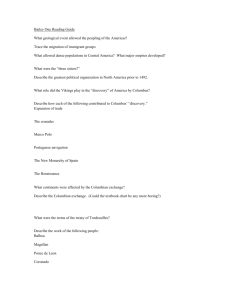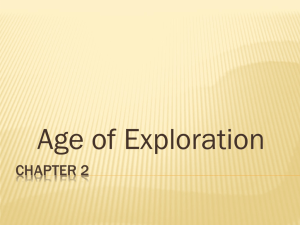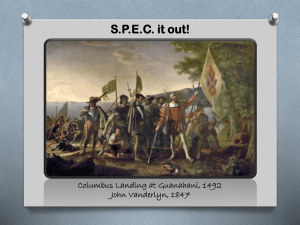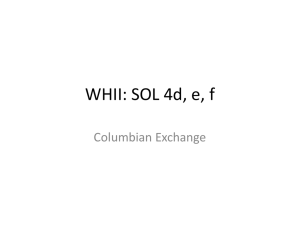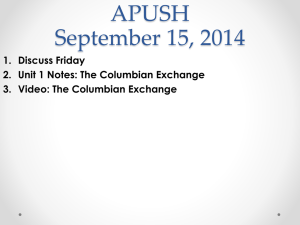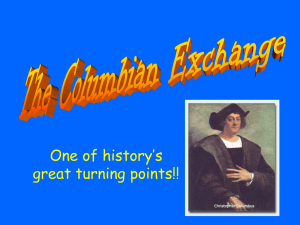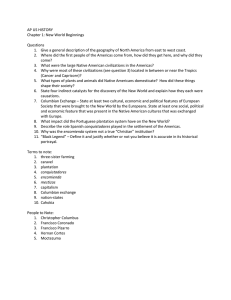TOPIC: Pre-Famine History SUBJECT/GRADE LEVEL: Social Studies, Grade Level 9
advertisement
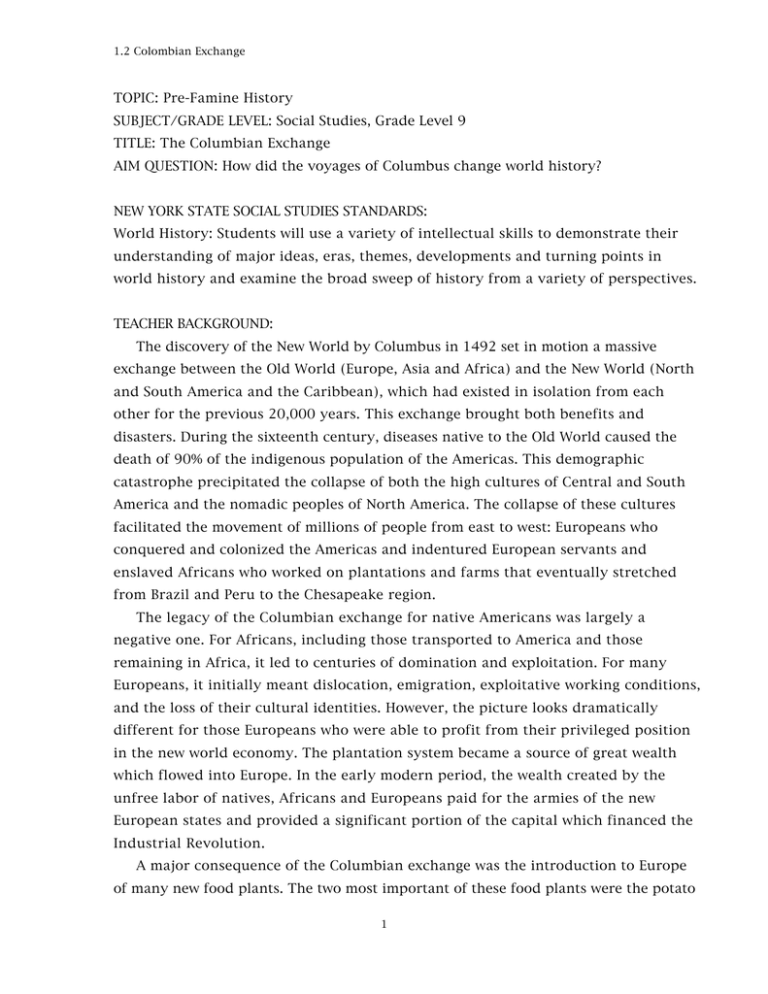
1.2 Colombian Exchange TOPIC: Pre-Famine History SUBJECT/GRADE LEVEL: Social Studies, Grade Level 9 TITLE: The Columbian Exchange AIM QUESTION: How did the voyages of Columbus change world history? NEW YORK STATE SOCIAL STUDIES STANDARDS: World History: Students will use a variety of intellectual skills to demonstrate their understanding of major ideas, eras, themes, developments and turning points in world history and examine the broad sweep of history from a variety of perspectives. TEACHER BACKGROUND: The discovery of the New World by Columbus in 1492 set in motion a massive exchange between the Old World (Europe, Asia and Africa) and the New World (North and South America and the Caribbean), which had existed in isolation from each other for the previous 20,000 years. This exchange brought both benefits and disasters. During the sixteenth century, diseases native to the Old World caused the death of 90% of the indigenous population of the Americas. This demographic catastrophe precipitated the collapse of both the high cultures of Central and South America and the nomadic peoples of North America. The collapse of these cultures facilitated the movement of millions of people from east to west: Europeans who conquered and colonized the Americas and indentured European servants and enslaved Africans who worked on plantations and farms that eventually stretched from Brazil and Peru to the Chesapeake region. The legacy of the Columbian exchange for native Americans was largely a negative one. For Africans, including those transported to America and those remaining in Africa, it led to centuries of domination and exploitation. For many Europeans, it initially meant dislocation, emigration, exploitative working conditions, and the loss of their cultural identities. However, the picture looks dramatically different for those Europeans who were able to profit from their privileged position in the new world economy. The plantation system became a source of great wealth which flowed into Europe. In the early modern period, the wealth created by the unfree labor of natives, Africans and Europeans paid for the armies of the new European states and provided a significant portion of the capital which financed the Industrial Revolution. A major consequence of the Columbian exchange was the introduction to Europe of many new food plants. The two most important of these food plants were the potato 1 1.2 Colombian Exchange and maize (yellow corn). The potato became an important staple to peoples around the world because of its high nutritional value and adaptability. The potato produces an extraordinarily high nutritional value per unit of land compared to other food crops. The potato can also be cultivated on a small scale in soil which is too poor to sustain other crops and in a wide variety of temperate climates. As a result, the potato has become a supplement or addition to existing agricultural products and, in times of famine, it has frequently served as an alternative to them. The potato made the breakthrough to a staple crop between 1750 and 1840. Although this breakthrough took place across the entire continent, the potato has been linked to the achievements and the misfortunes of the Irish to a far greater extent than it has to the history of any other country. 2 1.2 Colombian Exchange AIM: How did the voyages of Columbus change world history? ASSESSMENT: - Students will demonstrate an understanding of cause and effect in history and the ability to support conclusions based on an evaluation of evidence through individual and group writing assignments and during group and class discussions. - Students will demonstrate the importance of examining and respecting multiple perspectives on explaining historical events. - Students will acquire and explain the significance of information from charts. - Students will consider the possibility of alternative historical development. DO NOW ACTIVITY: Read Activity Sheet A: A Voyage that Changed the World and answer questions 1 and 2. MOTIVATIONAL ACTIVITY: Christopher Columbus failed to find a western water route from Europe to Asia. In your opinion, why are his voyages considered a major event in world history? Do you agree? Why or why not? TRANSITIONAL ACTIVITY: In your opinion, looking at the past, would people of Native American and African ancestory view the voyage of Columbus in the same way as people of European ancestory? Why? ACTIVITIES: Examine Activity Sheet B, Impact of the Columbian Food Exchange. 1- Marco Polo brought the idea of pasta from China to Italy. What happened when this wheat-based noodle met tomatoes from the Americas? 2- Examine chart 1 and 2. In your opinion, who got the better bargain in the Columbian food exchange? Why? 3- Examine chart 3. What happened to the population of the world between 1650 and 1950? 4- Which areas of the world showed the greatest growth? the least? In your opinion, why was this the case? 5- In your opinion, how are these developments a result of the Columbian Exchange? - Divide students into six work teams. Each team examines a passage from Activity sheet C. A representative from each team explains to the class how their example of the Columbian exchange changed world history. SUMMARY QUESTION: How did the voyages of Columbus change world history? HOMEWORK: “Alternative Pasts and Presents.” Focusing on one or more of the Columbian exchanges, write a paragraph decribing how the world would be different if Columbus had now arrived in a “new world.” 3 1.2 Colombian Exchange APPLICATION: In your opinion, are there other historical events or examples of global interaction that impacted world history in ways similar to the Columbian exchange? Explain. PROJECT: - Design posters representing the impact of each of the Colombian exchanges. - Create a front-page newspaper announcing historical developments brought on by the Colombian exchange. - In your opinion, which Colombian exchange had the greatest impact on world history? Students should select and research a category, present their findings to class, and the entire class can discuss the reports and try to arrive at a consensus. REFLECTION: Teachers who field tested this lesson in 9th grade classes divided students into expert groups responsible for reporting to the rest of the class. Some teachers made this a two day lesson. They had students research topics for homework and assemble their findings the next day before reporting to class. Teachers used discussion to focus on ways that the world today is different from earlier eras. 4 1.2 Colombian Exchange ACTIVITY SHEET A: A Voyage that Changed the World (adapted from Hawke and Davis (1992), Seeds of Change, The Story of Cultural Exchange after 1492. Menlo Park, CA: Addison-Wesley, 1992) Introduction: In 1492, an Italian ship's captain, sailing under the banner of the King and Queen of Spain, navigated three small ships across the Atlantic Ocean. In the English speaking world, he is known as Christopher Columbus. Columbus failed to find a western water route from Europe to Asia. However, his voyage led to an exchange of cultures, people and products that eventually revolutionized life all over the earth. According to a National Museum of Natural History (Smithsonian Institute) exhibit created to commemorate the quinticenteniary (500th anniversay) of the voyage, the six fundamental exchanges that transformed the world were diseases, maize (corn), potatoes, horses, sugar, and human migration. Questions: 1- Columbus failed to find a western water route from Europe to Asia. In your opinion, why are his voyages considered a major event in world history? 2- In your opinion, looking at the past, would people of Native American and African ancestory view the voyage of Columbus in the same way as people of European ancestory? Why? 5 1.2 Colombian Exchange ACTIVITY SHEET B: Impact of the Columbian Food Exchange Chart 1) The Origin of Common Food Items Foods from the Americas Foods from Europe, Asia, and Africa Avocados, Beans, Chile peppers, Cocoa, Apples, Bananas, Barley, Beets, Maize (Corn), Peanuts, Pineapples, Cabbage, Cattle, Coffee, Grapes, Oats, Potatoes, Pumpkins, Squashes, Olives, Onions, Oranges, Pigs, Rice, Sweet potatoes, Tomatoes, Turkeys Sugar Cane, Sheep, Tea, Wheat Chart 2) Food Value of Old and New World Crops Chief New World Crops (millions of calories per hectare) Chief Old World Crops Maize 7.3 Rice 7.3 Potatoes 7.5 Wheat 4.2 Sweet potatoes and yams 7.1 Barley 5.1 Oats 5.5 Source: Alfred Crosby, The Columbian Exchange. Biological and Cultural Consequences of 1492 (Greenwood Publishing, 1972), p. 175. Chart 3) World Population in millions of People 1650 1750 1800 1850 1900 1950 Africa 100 95 90 95 120 198 Asia 327 475 597 741 915 1,320 Latin America 12 11 19 33 65 162 North America 1 1 6 26 81 168 103 144 192 274 423 593 2 2 2 2 6 13 545 728 906 1,171 1,608 2,454 Europe and USSR Oceania Total Source: Alfred Crosby, The Columbian Exchange. Biological and Cultural Consequences of 1492 (Greenwood Publishing, 1972), p. 166. Questions 1- Marco Polo brought the idea of pasta from China to Italy. What happened when this wheat-based noodle met tomatoes from the Americas? 2- Examine chart 1 and 2. In your opinion, who got the better bargain in the Columbian food exchange? Why? 3- Examine chart 3. What happened to the population of the world between 1650 and 1950? 4- Which areas of the world showed the greatest growth? the least? In your opinion, why was this the case? 5- In your opinion, how are these developments a result of the Columbian Exchange? 6 1.2 Colombian Exchange ACTIVITY SHEET C: A Voyage that Changed the World (adapted from Hawke and Davis (1992), Seeds of Change, The Story of Cultural Exchange after 1492. Menlo Park, CA: Addison-Wesley, 1992) A) Devastating Diseases: For a number of reasons, the small bands of people who first settled the Americas had few infectious diseases. People who were sick probably did not survive the harsh Arctic climate during migration from Asia. In most parts of the Americas, human populations were small and people were spread out over a wide area, so contagious diseases could not easily be transmitted to other groups. In Europe, Africa and Asia, many diseases spread from farm animal to human populations. But in the Americas, there were fewer domesticated animals. When Europeans and Africans arrived in the Americas, they unknowingly brought highly infectious diseases along with them. According to one Spanish historian, the native population of the island of Hispaniola declined from an estimated million people to fewer than a thousand people in only thirty years because of small pox. Other old world diseases included measlers, influenza, malaria and chicken pox. Eventually disease and brutal treatment by European conquerers killed millions of native people in the Americas. B) Amazing Maize: Many historians believe that the single most important development in human history was the discovery of farming or agriculture. Before humans discovered farming, they had to continually search for food as hunters and gatherers. Actually farming was discovered on a number of different occasions in different parts of the world. Wheat and barley were first grown in the "Fertile Crescent" of southwest Asia. In China, people discovered how to grow rice and soybeans. African farmers learned how to grow sorghum, millets, yams, and watermelons. Sugar cane was probably first domesticated in New Guinea. In the Americas, people discovered how to plant and harvest maize, beans, squash, and potatoes. Maize was first grown in an area near present-day Mexico City. It was perhaps the most difficult crop to develop because it does not grow in the wild. Maize, which was later called Indian corn and corn, became the staple crop of the Mayan, Aztec and Incan civilizations. In Europe after the Colombian exchange, maize (corn) became a major animal feed crop and helped support larger human populations. C) The Popular Potato: Some scientists argue that potatoes are the most nutritious food eaten by human beings. It supplies vitamins, minerals, and fiber. Combined with whole milk, potatoes provide almost all the nuitrition people need to remain healthy. 7 1.2 Colombian Exchange Potato agriculture was discovered by people living in the high Andes of South America near Lake Titicaca. It later helped the Inca people create a powerful empire. The Inca understood the importance of the potato in their way of life. In their art they used images of potatoes. They even worshiped potato spirits in religious ceremonies. After the Columbian exchange, potatoes helped to transform Europe. European potato crops helped provide enough extra food so that people could move off of farms into towns and cities. They became the work force of the industrial revolution. In Ireland, potato production made possible enormous population growth. Between 1700 and 1840, the Irish population grew by about seven times. D) The Lengendary Horse: Native American people on the Great Plains of North America depended on horses for travel, hunting buffalo, and warfare. They were so successful that for years they resisted European and United States efforts to conquer and settle on the plains. Yet before the Colombian exchange there were no horses in the Americas. They had been extinct for thousands of years. The Spanish brought horses to the Americas and they played an important role in the conquest of native people. Sometimes people thought horses were monsters or messengers of the Gods. Armed and armoured Spanish soldiers, mounted on horses, were imposing warriors. In 1680, Pueblo Indians defeated the Spanish in a battle near Santa Fé. They destroyed a Spanish settlement and captured or set free thousands of their horses. These horses multipled in the wild and were the start of vast herds that spread across the Great Plains. Eventually these horses transformed Native American life. E) Bittersweet Sugar: Sugarcane is a grass whose stalk contains a sweet juice. Cane is cut and ground up to extract the juice and the juice is boiled to produce sugar. Sugarcane is native to the old world, but it grew well in the islands of the Caribbean. Before the Colombian exchange, sugar, from Africa, was a rare luxury item in Europe. Once it was grown in the Americas, it became a major and valuable trade item. Sugar production is a labor intensive industry. Large numbers of workers are needed to cut and process the cane. Europe turned to Africa for its labor supply. Millions of Africans were kidnapped, taken away from their homes and families, and brought to the Americas to work as slaves on large planations. As the Atlantic slave trade was destroying African societies, European countries grew rich from sugar production and the trade in human beings. 8 1.2 Colombian Exchange F) Human Migration: Before the Colombian Exchange, most people lived in relative geographic and cultural isolation. They rarely met people from outside their region or even knew of their existence. The Colombian exchange unleashed massive human movement across the planet. Millions of Africans and Europeans migrated to the Americas. The European languages of English, French, Spanish, Dutch, and Portugese are now spoken around the world. European culture and religions now predominate in most of North and South America, while African beliefs and customs are strong in the Carribean and Brazil. Much of the population of Latin America is Mestizo, blending the cultural and biologicial heritages of native peoples and Europeans. As world trade increased and economies expanded, contact between people increased. Cultures were shared. Other groups of people began to migrate. Just as the initial exchange brought both positive and negative developments, the new exchanges had mixed results. Knowledge, industry, and technology have all increased, but so has war and the exploitation of the natural environment. 9
